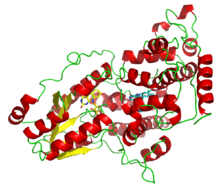Photolyase
| FAD binding domain of DNA photolyase | |||||||||
|---|---|---|---|---|---|---|---|---|---|
 A deazaflavin photolyase from Anacystis nidulans, illustrating the two light-harvesting cofactors: FADH- (yellow) and 8-HDF (cyan). | |||||||||
| Identifiers | |||||||||
| Symbol | FAD_binding_7 | ||||||||
| Pfam | PF03441 | ||||||||
| InterPro | IPR005101 | ||||||||
| PROSITE | PDOC00331 | ||||||||
| SCOP | 1qnf | ||||||||
| SUPERFAMILY | 1qnf | ||||||||
| |||||||||
Photolyases (EC 4.1.99.3) are DNA repair enzymes that repair damage caused by exposure to ultraviolet light. This enzyme mechanism[1] requires visible light, preferentially from the violet/blue end of the spectrum, and is known as photoreactivation.
Photolyase is a phylogenetically old enzyme which is present and functional in many species, from the bacteria to the fungi to plants and to the animals.[2] Photolyase is particularly important in repairing UV induced damage in plants. However it is no longer working in humans and other placental mammals who instead rely on the less efficient nucleotide excision repair mechanism.[3]
Photolyases bind complementary DNA strands and break certain types of pyrimidine dimers that arise when a pair of thymine or cytosine bases on the same strand of DNA become covalently linked. These dimers result in a 'bulge' of the DNA structure, referred to as a lesion. The more common covalent linkage involves the formation of a cyclobutane bridge. Photolyases have a high affinity for these lesions and reversibly bind and convert them back to the original bases.

Photolyases are flavoproteins and contain two light-harvesting cofactors. All photolyases contain the two-electron-reduced FADH-; they are divided into two main classes based on the second cofactor, which may be either the pterin methenyltetrahydrofolate (MTHF) in folate photolyases or the deazaflavin 8-hydroxy-7,8-didemethyl-5-deazariboflavin (8-HDF) in deazaflavin photolyases. Although only FAD is required for catalytic activity, the second cofactor significantly accelerates reaction rate in low-light conditions. The enzyme acts by electron transfer in which the reduced flavin FADH- is activated by light energy and acts as an electron donor to break the pyrimidine dimer.[4]
On the basis of sequence similarities DNA photolyases can be grouped into two classes. The first class contains enzymes from Gram-negative and Gram-positive bacteria, the halophilic archaebacteria Halobacterium halobium, fungi and plants. Proteins containing this domain also include Arabidopsis thaliana cryptochromes 1 and 2, which are blue light photoreceptors that mediate blue light-induced gene expression and modulation of circadian rhythms.
Some sunscreens include photolyase in their ingredients, claiming a reparative action on UV-damaged skin.[5]
Human proteins containing this domain
CRY1; CRY2;
References
- ↑ V. Thiagarajan, M. Byrdin, A.P.M. Eker, P. Müller & K. Brettel (2011). "Kinetics of cyclobutane thymine dimer splitting by DNA photolyase directly monitored in the UV". Proc. Natl. Acad. Sci. USA 108: 9402–9407. doi:10.1073/pnas.1101026108.
- ↑ Selby, Christopher P.; Sancar, Aziz (21 November 2006). "A cryptochrome/photolyase class of enzymes with single-stranded DNA-specific photolyase activity". Proceedings of the National Academy of Sciences of the United States of America 103 (47): 17696–700. doi:10.1073/pnas.0607993103. PMC 1621107. PMID 17062752.
- ↑ Michael Lynch, José Ignacio Lucas-Lledó; Lynch, M. (19 February 2009). "Evolution of Mutation Rates: Phylogenomic Analysis of the Photolyase/Cryptochrome Family". Molecular Biology and Evolution 26 (5): 1143–1153. doi:10.1093/molbev/msp029. PMC 2668831. PMID 19228922.
- ↑ Sancar, A. (2003). "Structure and function of DNA photolyase and cryptochrome blue-light photoreceptors". Chem Rev 103 (6): 2203–37. doi:10.1021/cr0204348. PMID 12797829.
- ↑ Kulms, Dagmar; Pöppelmann, Birgit; Yarosh, Daniel; Luger, Thomas A.; Krutmann, Jean; Schwarz, Thomas (1999). "Nuclear and cell membrane effects contribute independently to the induction of apoptosis in human cells exposed to UVB radiation". PNAS 96 (14): 7974–7979. doi:10.1073/pnas.96.14.7974. PMC 22172. PMID 10393932.
| ||||||||||||||||||||